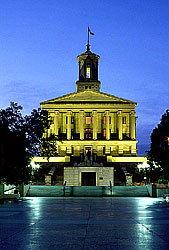

State Capitol Building |
The first settlers in what is now known as Nashville were Indians
of the Mississippian culture, who lived in the area about 1000
to 1400 A.D. They raised corn, made great earthen mounds, painted
beautiful pottery -- and then mysteriously disappeared. Other Indians,
the Cherokee, Chicksaw and Shawnee, followed and used the area
as a hunting ground. French fur traders, who established a trading
post, came to the area around 1717. The first settlement, however,
was not established until 1779. It was then, on the banks of the
Cumberland near the center of present downtown Nashville, that
a band of pioneers led by Englishman James Robertson cleared the
land and built a log stockade. This was Fort Nashborough, named
in honor of General Francis Nash who won acclaim in the Revolutionary
War. John Donelson and some 60 families followed in April, 1780,
to settle the new community that was then a part of North Carolina.
In 1784 the community's name was changed from Nashborough to Nashville.
Tennessee became the sixteenth state in 1796 and Nashville was
made its permanent capital in 1843.
By 1860 Nashville was a prosperous city, soon to be devastated
by the Civil War. Because of its strategic location on the river
and the railroad, the city was occupied by Federal troops for
three years. The Battle of Nashville, fought in 1864, was the
last aggressive action of the Confederate Army.
In the decades following the war, Nashville once again experienced
a growth in population, business and industry and education.
Another area of growth was in country music, which has grown
to the point that Nashville today is known as Music City, USA.
Under its present Metropolitan Charter, which became effective
April 1, 1963, Nashville and Davidson County have a single government
with its authority encompassing more than a half-million people
and 533 square miles. This widespread area is governed by a mayor
, a vice-mayor and a legislative council of 40 members |


![]()